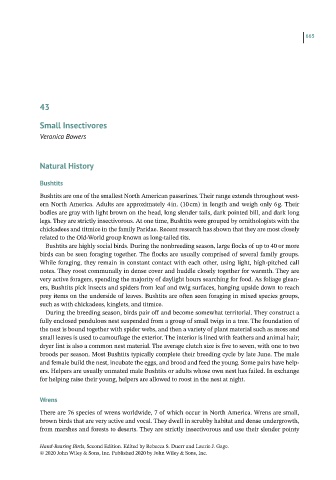Page 664 - Hand rearing birds second
P. 664
665
43
Small Insectivores
Veronica Bowers
Natural History
Bushtits
Bushtits are one of the smallest North American passerines. Their range extends throughout west-
ern North America. Adults are approximately 4 in. (10 cm) in length and weigh only 6 g. Their
bodies are gray with light brown on the head, long slender tails, dark pointed bill, and dark long
legs. They are strictly insectivorous. At one time, Bushtits were grouped by ornithologists with the
chickadees and titmice in the family Paridae. Recent research has shown that they are most closely
related to the Old‐World group known as long‐tailed tits.
Bushtits are highly social birds. During the nonbreeding season, large flocks of up to 40 or more
birds can be seen foraging together. The flocks are usually comprised of several family groups.
While foraging, they remain in constant contact with each other, using light, high‐pitched call
notes. They roost communally in dense cover and huddle closely together for warmth. They are
very active foragers, spending the majority of daylight hours searching for food. As foliage glean-
ers, Bushtits pick insects and spiders from leaf and twig surfaces, hanging upside down to reach
prey items on the underside of leaves. Bushtits are often seen foraging in mixed species groups,
such as with chickadees, kinglets, and titmice.
During the breeding season, birds pair off and become somewhat territorial. They construct a
fully enclosed pendulous nest suspended from a group of small twigs in a tree. The foundation of
the nest is bound together with spider webs, and then a variety of plant material such as moss and
small leaves is used to camouflage the exterior. The interior is lined with feathers and animal hair;
dryer lint is also a common nest material. The average clutch size is five to seven, with one to two
broods per season. Most Bushtits typically complete their breeding cycle by late June. The male
and female build the nest, incubate the eggs, and brood and feed the young. Some pairs have help-
ers. Helpers are usually unmated male Bushtits or adults whose own nest has failed. In exchange
for helping raise their young, helpers are allowed to roost in the nest at night.
Wrens
There are 76 species of wrens worldwide, 7 of which occur in North America. Wrens are small,
brown birds that are very active and vocal. They dwell in scrubby habitat and dense undergrowth,
from marshes and forests to deserts. They are strictly insectivorous and use their slender pointy
Hand-Rearing Birds, Second Edition. Edited by Rebecca S. Duerr and Laurie J. Gage.
© 2020 John Wiley & Sons, Inc. Published 2020 by John Wiley & Sons, Inc.

